Imagine a library without a filing system. Finding a specific book would be a nightmare. Data structures are like the filing system for computer programs, organizing information for efficient storage, retrieval, and manipulation. This article dives into the world of data structures, explaining what they are, why they are important, and the different types you will encounter.
A data structure is a collection of data values and the relationships between them. Data structures allow programs to store and process data effectively. There are many different data structures, each with its own advantages and disadvantages. Some of the most common data structures are arrays, lists, trees, and graphs.
In this Data structure tutorial for beginners, you will learn about:
- What is Data structure
- Need for Data Structure
- Types of Data Structure
- Types of Linear Data Structure
- Types of Non-Linear Data Structure
- Classification of Data Structure
What is a Data Structure?
A data structure is a specialized format for organizing, storing, and accessing data within a computer’s memory. Different data structures excel at different tasks. An array, for instance, is ideal for storing a fixed-size collection of similar items, like a list of student grades. On the other hand, a linked list is more flexible, enabling you to add or remove items dynamically, making it perfect for tasks like managing a to-do list.
The data structure isn’t a programming language like C, C++, Java, etc. It is a set of algorithms that can be used in any programming language to organize the data in the memory.
Here is the list of courses to learn data structure for a particular programming language
- Data structure and algorithms in java
- Data structure in c
- Data structure in Java
- Python data structure
‘n’ number of algorithms were proposed to organize the data in memory. These algorithms are referred to as Abstract data types. Abstract data types are nothing but a set of rules.
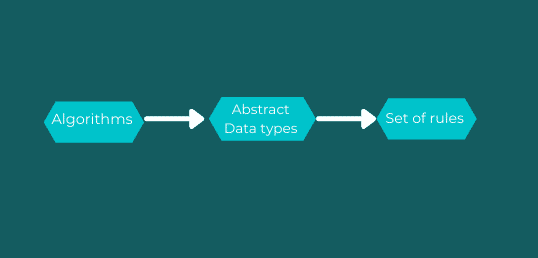
Why are Data Structures Important?
Data structures are the foundation of efficient programs. They play a crucial role in:
- Performance: Choosing the right data structure significantly impacts how quickly your program can access and process information. For example, searching an unsorted list takes much longer than searching a sorted array.
- Memory Management: Data structures help optimize memory usage, preventing wasted space and improving program efficiency.
- Code Reusability: Well-defined data structures can be reused across different parts of your program or even other programs, saving development time and promoting consistency.
Types of Data Structure
- Linear Data Structures: Items are arranged sequentially, like beads on a string. Examples include:
- Arrays: Store a fixed-size collection of elements of the same data type, accessed using an index (position). They are efficient for random access but not ideal for frequent insertions or deletions in the middle.
- Linked Lists: Offer more flexibility than arrays, as elements (nodes) are not stored contiguously in memory. Each node contains data and a reference (pointer) to the next node in the list. This allows for dynamic insertion and deletion, but random access is slower.
- Stacks: Follow a Last-In-First-Out (LIFO) principle, similar to a stack of plates. The most recently added element is accessed and removed first (like popping a plate off the top). Stacks are useful for implementing undo/redo functionality or keeping track of function calls.
- Queues: Function on a First-In-First-Out (FIFO) basis, like a line at a coffee shop. The added element is the first to be retrieved (think people leaving the line one by one). Queues are often used to manage tasks or process requests in a specific order.
- Non-Linear Data Structures: Relationships between elements are not strictly linear. They provide a more flexible way to organize complex data. Here are some common examples:
- Trees: Hierarchical structures with a root node, child nodes, and potentially sub-trees. Binary trees have a maximum of two child nodes per parent, while N-ary trees can have any number of children. Trees efficiently search and sort data, especially when dealing with hierarchical relationships. Binary Search Trees (BSTs) are a specific type of binary tree that keeps elements sorted for faster searching.
- Graphs: Consist of nodes (vertices) connected by edges. Graphs model relationships between objects, like social networks or transportation systems.
There are other 2 types of Data Structure :
- Primitive Data Structure
- Non – Primitive Data Structure
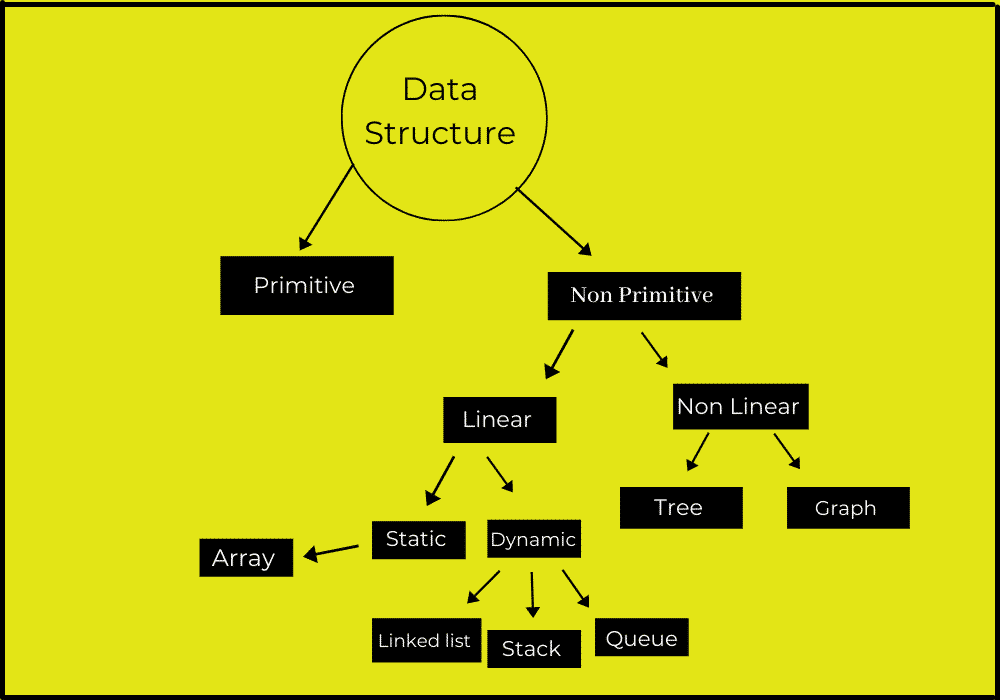
Primitive Data Structure –
Primitive Data Structures directly operate according to the machine instructions. These are the primitive data types. Data types like int, char, float, double, and pointer are primitive data structures that can hold a single value.
Non – Primitive Data Structure –
Non-primitive data structures are complex data structures that are derived from primitive data structures. Non – Primitive data types are further divided into two categories.
- Linear Data Structure
- Non – Linear Data Structure
Linear Data Structure –
Linear Data Structure consists of data elements arranged in a sequential manner where every element is connected to its previous and next elements. This connection helps to traverse a linear arrangement in a single level and in a single run. Such data structures are easy to implement as memory is additionally sequential. Some examples of Linear Data Structure are List, Queue, Stack, Array etc.
Types of Linear Data Structure –
1] Arrays –
An array is a collection of similar data elements stored at contiguous memory locations. It is the simplest data structure where each data element can be accessed directly by only using its index number.
2] Linked List –
A linked list is a linear data structure that is used to maintain a list-like structure in the computer memory. It is a group of nodes that are not stored at contiguous locations. Each node of the list is linked to its adjacent node with the help of pointers.
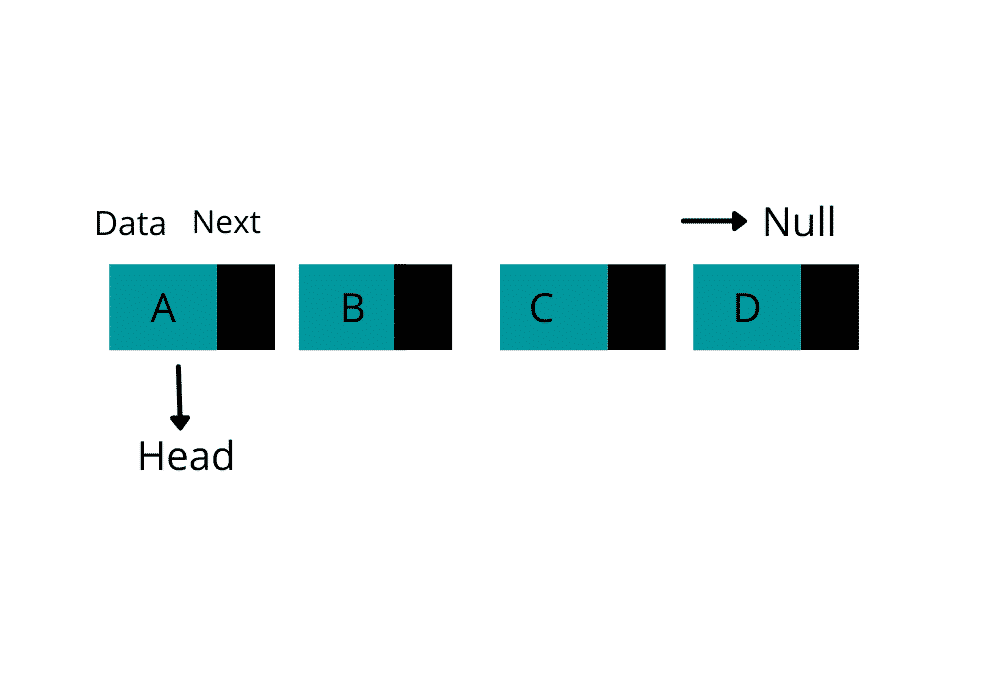
3] Stack –
Stack is a linear data structure that follows a specific order during which the operations are performed. The order could be FILO (First In Last Out) or LIFO (Last In First Out).
The basic operations performed in stack are as follows :
- Push – Adds an item within the stack.
- Pop – Deletes or removes an item from the stack.
- Top – Returns the topmost element of the stack.
- IsEmpty – Returns true if the stack is empty.
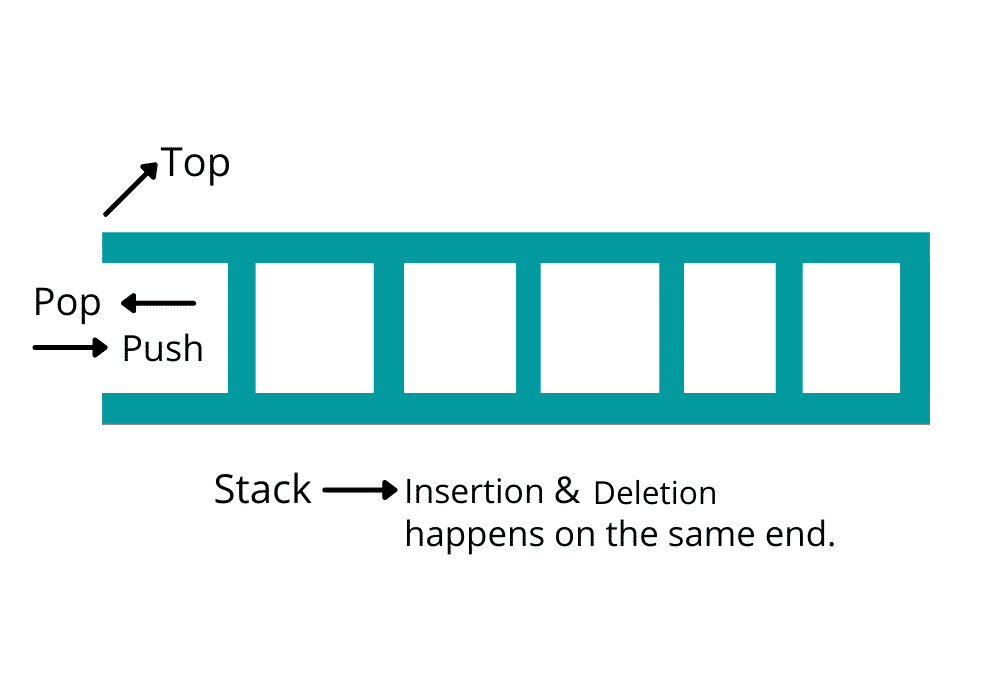
4] Queue –
Queue is a linear data structure in which elements can be inserted from only one end which is known as rear and deleted from another end known as front. It follows the FIFO (First In First Out) order.
- Deque – Adds an element to the queue.
- Enqueue – Deletes or removes an element from the queue.
- IsFull – Returns true if the queue is full.
- IsEmpty – Returns true if the queue is empty.
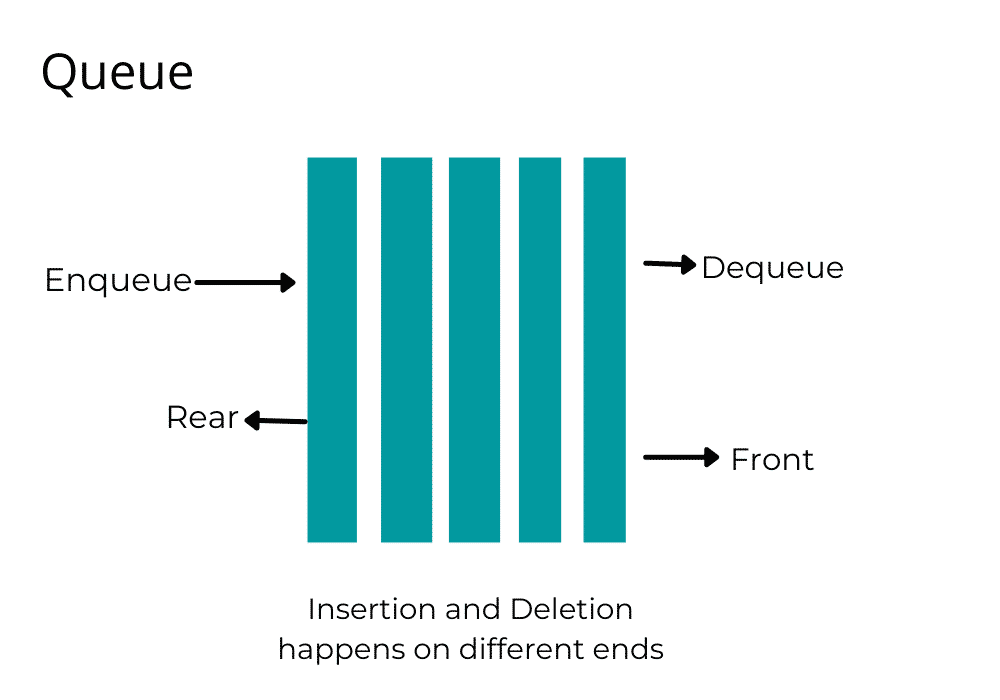
Non-Linear Data Structure –
Non-linear Data Structures do not have any set sequence of connecting all its elements and every element can have multiple paths to attach to other elements. Such data structures support multi-level storage and sometimes can’t be traversed in a single run. Such data structures aren’t easy to implement but are more efficient in utilizing memory. Some examples of non-linear data structures are Tree, BST, Graphs etc.
Types of Non-Linear Data Structure
1] Tree –
A tree is a multilevel data structure defined as a set of nodes. The topmost node is named root node while the bottom most nodes are called leaf nodes. Each node has only one parent but can have multiple children.
Types of Trees in Data structure
- General Tree
- Binary Tree
- Binary Search Tree
- AVL Tree
- Red Black Tree
- N-ary Tree
2] Graph
A graph is a pictorial representation of a set of objects connected by links known as edges. The interconnected nodes are represented by points named vertices, and the links that connect the vertices are called edges.
Types of Graph
- Finite Graph
- Infinite Graph
- Trivial Graph
- Simple Graph
- Multi Graph
- Null Graph
- Complete Graph
- Pseudo Graph
- Regular Graph
- Bipartite Graph
- Labeled Graph
- Diggraph Graph
- Subgraph
- Connected or Disconnected Graph
- Cyclic Graph
- Vertex Labelled Graph
- Directed Acyclic Graph
A graph is a pair of sets (V, E), where V is the set of vertices and E is the set of edges.
Classification of Data Structure
Data Structure can be further classified as
- Static Data Structure
- Dynamic Data Structure
Static Data Structure
Static Data Structures are data structures where the size is allocated at the compile time. Hence, the maximum size is fixed and cannot be changed.
Dynamic Data Structure
Dynamic Data Structures are data structures where the size is allocated at the run time. Hence, the maximum size is flexible and can be changed as per requirement.
Data Structure Operations –
The common operations that can be performed on the data structures are as follows :
- Searching – We can easily search for any data element in a data structure.
- Sorting – We can sort the elements either in ascending or descending order.
- Insertion – We can insert new data elements in the data structure.
- Deletion – We can delete the data elements from the data structure.
- Updation – We can update or replace the existing elements from the data structure.
Advantages of Data Structure –
- Data structures allow storing the information on hard disks.
- An appropriate choice of ADT (Abstract Data Type) makes the program more efficient.
- Data Structures are necessary for designing efficient algorithms.
- It provides reusability and abstraction.
- Using appropriate data structures can help programmers save a good amount of time while performing operations such as storage, retrieval, or processing of data.
- Manipulation of large amounts of data is easier.
Data Structure Applications
- Organization of data in a computer’s memory
- Representation of information in databases
- Algorithms that search through data (such as a search engine)
- Algorithms that manipulate data (such as a word processor)
- Algorithms that analyze data (such as a data miner)
- Algorithms that generate data (such as a random number generator)
- Algorithms that compress and decompress data (such as a zip utility)
- Algorithms that encrypt and decrypt data (such as a security system)
- Software that manages files and directories (such as a file manager)
- Software that renders graphics (such as a web browser or 3D rendering software)
Popular Data Structures and Their Uses Hash Tables
Implement a technique called hashing to store key-value pairs. A hash function converts a key into a unique index, allowing for fast retrieval of the associated value. This is similar to how a dictionary helps you quickly find a specific word definition. Hash tables are essential for databases and other applications requiring efficient key access. Python Data Structures: Python offers built-in data structures, like tuples (immutable lists), dictionaries (hash tables), and sets (collections of unique elements). These structures make Python popular for data science and machine learning applications. Data Structures in C/C++: C and C++ provide fundamental data structures like arrays, structures (user-defined composite data types), and pointers (variables that store memory addresses). Understanding these is crucial for system programming and performance-critical applications. Data Structures and Algorithms Interview Questions: Data structures are fundamental to computer science and are frequently tested in coding interviews. Familiarizing yourself with common operations like searching, sorting, insertion, and deletion for various data structures will give you an edge.
Data Structures for Programming
Data structures are the hidden building blocks that empower efficient and well-organized programs. By understanding different data structures and their strengths and weaknesses, you can make informed decisions when designing algorithms and crafting optimal solutions. Mastering data structures will equip you to tackle complex problems and write elegant, efficient code.
Programming is a learning process. Experiment with different structures and apply your knowledge to solve real-world problems. As you become proficient, you will witness the power of data structures in crafting exceptional software solutions. Continue learning and boost your career with free courses with certificates and gain certifications in data structures and more.
Concluding Thoughts
Data Structures remain the most important aspect of a career in tech. A PGP in Software Development is your one-stop solution to further your learning and land a job in your dream company.






